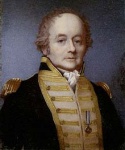Ships involved.
United Kingdom.
Nelson's squadron.
Polyphemus 64 Captain John Lawford
Isis 50 Captain James Walker
Edgar 74 Captain George Murray
Ardent 64 Captain Thomas Bertie
Glatton 54/56 Captain William Bligh
Elephant 74 flag of Vice-Adm. Lord Nelson, Captain Thomas Foley
Ganges 74 Captain Thomas Francis Fremantle
Monarch 74 Captain James Robert Mosse †
Defiance 74 2nd flag of Rear-Adm. Thomas Graves, Captain Richard Retalick
Russell 74 Captain William Cuming
Bellona 74 Captain Thomas Boulden Thompson
Agamemnon 64 Captain Robert Devereux Fancourt
Désirée 36 Captain Henry Inman
Amazon 38 Captain Edward Riou †
Blanche 36 Captain Graham Eden Hamond
Alcmène 32 Captain Samuel Sutton
Jamaica 24 Captain Jonas Rose
Arrow ship-sloop Captain William Bolton
Dart ship-sloop Captain John Ferris Devonshire
Cruizer brig-sloop, Cmdr. James Brisbane
Harpy brig-sloop, Cmdr. William Birchal
Discovery bomb, Cmdr. John Conn
Explosion bomb, Cmdr. John Henry Martin
Hecla bomb, Cmdr. Richard Hatherhill
Sulphur bomb, Cmdr. Hender Whitter
Terror bomb, Cmdr. Samuel Campbell Rowley
Volcano bomb, Cmdr. James Watson
Zebra bomb, Cmdr. Edward Sneyd Clay
Otter fireship, Cmdr. George M'Kinley
Zephyr fireship, Cmdr. Clotworthy Upton
Parker's reserve.
London 98 flag of Admiral Sir Hyde Parker, with 1st Captain William . Domett and 2nd Captain Robert Walker Otway
St George 98 Captain Thomas Masterman Hardy
Warrior 74 Captain Charles Tyler
Defence 74 Captain Henry Paulet
Saturn 74 Captain Robert Lambert
Ramillies 74 Captain James William Taylor Dixon
Raisonnable 64 Captain John Dilkes
Veteran 64 Captain Archibald Collingwood Dickson
Rob.







 Reply With Quote
Reply With Quote
Bookmarks